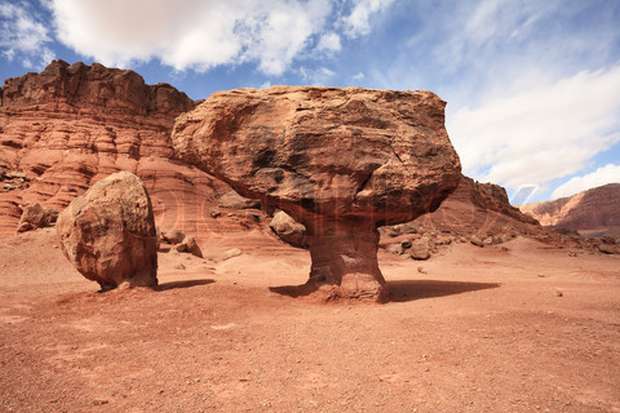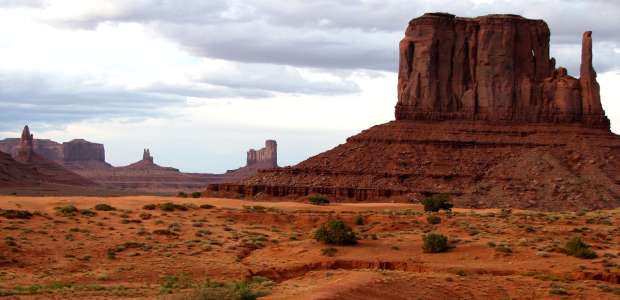On a high, barren plain in Arizona, massive outcrops of red sandstone are etched against the sky like fragmented architectural relics. The unique beauty of Monument Valley resides in its statuesque rocks, its dry clear air and the lengthening shadows of its monuments as the desert sun sets. The valley, which straddles the Utah-Arizona border in the south-western USA, is named after the strange stone monoliths that loom above the sagebrush plain, for geologists use the term ‘monument’ to describe those remnants of erosion that are higher than they are broad. This factor means that the time-worn rocks often resemble buildings and artefacts, and the landscape of Monument Valley is dominated by visions of crumbling castles, ancient temples, skyscrapers, pillars and spires.
The extraordinary shapes of many of these towers have prompted fanciful popular names. Castle rock is an impressive flat-topped plateau, or massif, 1000ft (300m) high, topped by crenellated ‘battlements’. The Mittens are a pair of formations that stand close together, each consists of a narrow column of rock, the thumb, beside a broader butte (a flat-topped hill or column of rock), resembling the fingers. Nearby, Hen-in-a-Nest bears a similarity to a squatting chicken, while the somber masses of Merrick Butte and Mitchell Butte might be natural replicas of giant tombstones. According to local folklore, their names commemorate two silver prospectors who were killed hereby Native Americans in the 1880s. The Prioress, at 800ft (245m) high the tallest of a group of rocks known as the Three Sisters, bears a remarkable resemblance to a cowled figure, her hands clasped in prayer.
Monument Valley was not always such an impressive landscape of isolated buttes and mesas. About 250 million years ago, its red sands were covered by a shallow sea. Heavy mud deposits collected on the seabed as sediment compressing the sand into porous sandstone, while the mud itself gradually turned into shale. Slowly, the sea receded and – some 70 million years ago – the Earth’s crust thrust violently upwards, forming a wide, bulbous dome before cooling and solidifying again. What had once been the seabed was now an enormous plateau of sandstone with a covering of shale and conglomerate (a coarse sedimentary rock consisting largely of pebbles and gravel). Over millions of years, these exposed rock layers were transformed by wind and water, first into large plateau crisscrossed by canyons and gullies, then into smaller mesas and finally into tall columns or buttes.
Some layers of rock defy the erosive powers of wind and rain better than others. On a distinctive mushroom-shaped formation shown below, a resistant cap of harder rock both protects and is supported by a more eroded sub-layer.

A dramatic scenery of Monument Valley provided the ideal backdrop for John Ford’s US cavalry film, She Wore a Yellow Ribbon. Ford made more than 25 movies here, and many commercials have been filmed against the valley’s other-worldly rock formations.
Like much of south-western USA, Monument Valley is spectacularly beautiful but deeply inhospitable to both humans and wildlife. Apart from the Navajo, who still herd sheep and goats here, there is little sign of human habitation. The arid dunes and wasted scrubland support no game except rabbits and cold-blooded creatures that need little water, such as the collared lizard, the horned toad and the prairie rattlesnake. The yearly rainfall total rarely tops 8in (20cm), so the sparse vegetation is limited to a few hardy species – scrub juniper, sagebrush, pinyon pines and cacti – that can survive months without water. A sudden rainstorm often brings the buried seeds of dozens of wildflowers to life, briefly spattering the landscape with brilliant colour, but the fragile blossoms never last more than a day or two.
Over a century, Monument Valley appears to have changed little, but the processes of erosion are constantly at work and rock falls are daily occurrences. It may well be that the final lofty remnants of the sandstone plateau will, over hundreds of thousands of years, be flattened to leave a monotonous, level plain.



































